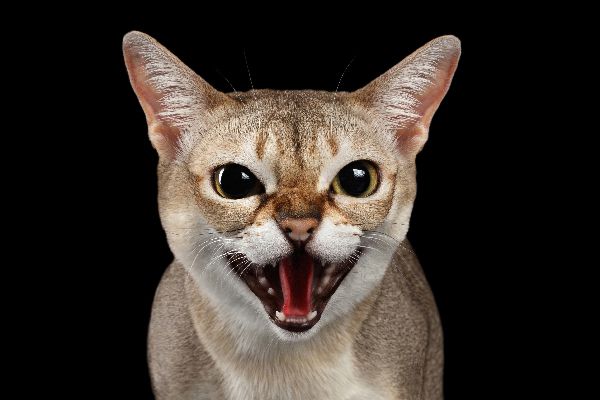Last Updated on September 3, 2023 by Fumipets
The Mystique of the Sphynx Cat: Elegance in the Absence of Fur
A Sphynx Cat unravels the unique charm and allure of these enchanting feline companions. The Sphynx cat, known for its hairless exterior, possesses a personality as captivating as its appearance. This summary delves into the history, distinctive traits, care requirements, and the exceptional bond one can form with a Sphynx cat, revealing that beneath their naked exterior lies a heart full of warmth and affection.
Sphynx Cat
Due to their inherent baldness, the sphynx cat type is distinctive and completely recognizable. The sphynx has its fair share of admirers as well as detractors who are not particularly taken with the breed’s lack of clothing. Regardless of your opinion of their bizarre look, these clownish cats make loyal, clever, and entertaining companions. The sphynx is an affectionate and sociable species that longs for your company and love, particularly the scritches that go along with it.
These hairless cats can be quite pricey due to their comparatively rare race. To purchase a sphynx cat, be prepared to reach far into your wallet: Depending on lineage, a sphynx pup from a respectable breeder typically costs between $1,500 and $6,000.
Appearance
Despite being referred to as a “hairless cat,” the sphynx doesn’t always have hair. These cats have a thin down hair that is difficult to see but is instantly noticeable (i.e., extremely velvety) to the touch. This is described as “giving the overall feel of soft, warm chamois leather” by the Sphynx Cat Club. A sphynx may have a few scant eyebrows and hairs to add even more individuality, or she may have none at all.
The epidermis of the sphynx cat is frequently colored or striped, just like a regular domestic cat. Sphynxes appear in a broad range of hues and patterns, just like furrier felines do. There is no dearth of variation, from tortoiseshell puppies with patterns to black sphynx cats with dark colors.
Female sphynx can weigh as little as 6 pounds, while bigger males can weigh as much as 14 pounds. Sphynx are classified as medium-sized cats. The perceived absence of hair is the definitive physical trait of the sphynx cat, but once you get passed the nudity, this species also has other distinguishing traits. They have huge, bat-like ears, long, finger-like toes (ideal for making biscuits), penetrating lemon-shaped pupils, a massive abdomen, and long, finger-like toes. Sphynx cats are truly extremely energetic, agile creatures with strong frames, despite having a rotund stomach.
Many obvious creases are another characteristic of sphynxes. These cats don’t have more wrinkles than other cats, but the absence of dense hair emphasizes this characteristic of all cats.
If there’s one thing you should be aware of before taking a sphynx home, it’s that she still needs to be groomed. She’s going to need a lot of maintenance in actuality.

Temperament
These stunning baldies are incredibly intelligent, inquisitive, and extroverted, and they aren’t afraid to express their requirements in a direct manner. Expect to have a lot of cat chatter as your companion accompanies you from room to room because sphynxes are loud.
Sphynx cats are comical, lovable, and born performers who will act foolish to get your attention. (and pats). These affectionate, sociable cats will stick by your side for hours. They won’t pass up the chance to cuddle up with you under a toasty comforter on a cool morning (or even on a not-so-cold day). Not all pet parents can handle their neediness, but those who do will be repaid with excellent company that’s difficult to obtain elsewhere. These cats are loving, devoted companions who will never stop caring for you.
Sphynxes are extremely clever and adaptable. They are a very social species, and they have never encountered a living object they didn’t show interest in.
If your sphynx enters any room, closet, or storage in the home, don’t be shocked. These cats are extremely nimble, with deft, finger-like digits they use to probe, prod, and open doors, and they are just as inquisitive as the old adage suggests. Before taking home a sphynx pup, you might want to perform some simple cat-proofing!
Living Needs
Sphynx cats are an energetic species that has a high need for mental and physical exercise. With toys and scratching posts, they can (and will) amuse themselves, but to truly be content, they require love and care from their favored people. These social creatures can’t survive on their own for extended stretches of time; they require a loving and patient master.
While sphynxes enjoy chasing ping-pong balls and tossing around feather objects, she also enjoys scaling and perching; neither a bookcase nor a niche is too small or narrow for her to rest on. The agile sphynx does best with room to roam, cat branches, and caretakers who don’t mind their houses turning into jungle gyms.
Sphynxes are usually seen wandering around in their underwear, which makes them more susceptible to the heat and the chill. Your sphynx will probably be drawn to warm areas of the home like sunlit windows, toasty vents, or even sneaking under the blankets with you. If you reside in a chilly environment, dress your cat in a cozy (yet fashionable) parka or cardigan.
However, there are advantages to being naked: Since their smooth bodies need frequent showers, sphynxes are apt to handle water better than most cats. The sphynx is also regarded as nontoxic due to their absence of hair. Even though there isn’t a companion that is genuinely hypoallergenic, cat enthusiasts who frequently sniffle or scratch around cats may find them to be a good option.
Sphynxes are lively and energetic, but they also have soft, relaxed spirits. They get along well with children, household canines, and other cats, particularly if they are exposed when they are puppies.
Care
If there’s one thing you should be aware of before taking a sphynx home, it’s that she still needs to be groomed. She’s going to need a lot of maintenance in actuality. Your cat’s skin can become oily, filthy, and even fragrant without cat hair, which soaks and isolates oil deposits. To maintain their finest appearance and health, sphynxes require at least weekly washing, frequent ear cleansing, and regular cuticle clipping. And take note: You will still need to take the standard flea measures because this bald cat is actually just as prone to fleas as its furrier peers.
You won’t need to exert extra effort to keep a sphynx’s feet moving because they are inherently busy creatures. You can anticipate them to follow the same routine as pretty much every other cat—long resting hours with high-energy bursts of racing, leaping, and playing—as long as you give them plenty of cat objects to keep them occupied.
These witty, inquisitive cats learn fast and delight to teach. The secret to teaching your cat new skills and instructions is positive feedback and tons of attention—a sphynx would adore learning catch!
A sphynx cat will get along with almost any family member, whether they have four legs or two, as they are sociable creatures. If anything, your sphynx might get into trouble because of her propensity to attract attention and her unquenchable interest. Keep a watch on her to make sure she doesn’t walk off to investigate the neighborhood. She should never be left outside unattended, just like any other cat.
Spyhnx cats consume more food than most cats because of their voracious appetites and large stomachs. Don’t worry about their rounder midsections, which are a perfectly healthy trait of this species; instead, keep a watch on their weight. To find out when, what food, and how frequently to give your sphynx, consult your veterinarian.
Sphynxes are usually seen wandering around in their underwear, which makes them more susceptible to the heat and the chill. If you reside in a chilly environment, dress your cat in a cozy (yet fashionable) parka or cardigan.
Health
The average longevity of sphynx cats is 9 to 15 years, and they are typically robust animals. But they are prone to some health problems, just like all types.
Dental illness, skin issues like sticky or slippery skin, and cardiac issues are common medical ailments found in sphynxes. The most prevalent cardiac condition affecting cats is hypertrophic cardiomyopathy (HCM), and sphynx animals are susceptible.
Hereditary myopathy is a disease that can affect sphynx cats, according to the Universities Federation for Animal Welfare. This results in muscular stiffness, which can prevent a cat from exercising or even moving around regularly.
Reputable sphynx breeders will examine your kitten’s health. It’s critical to keep up with your cat’s checkups and exams at the doctor because HCM and other health issues may not be discovered until later in your cat’s life.
History
A domestic shorthair cat in Ontario, Canada, gave birth to a hairless baby by the name of Prune in 1966. She was mated with a Devon rex in an effort to produce a hairless variety after her hereditary specialness was discovered.
Due to the sphynx’s similarity to the cats depicted in Egyptian hieroglyphics, the offspring of this cross were initially known as the Canadian Hairless Cat. Due to the limited gene pool of some of these early offspring, the cats that were produced were prone to health problems, and despite efforts to resuscitate the line, Prune’s line faded out in the early 1980s.
Prune, a domestic shorthair cat without hair, was the first sphynx. Since then, the Devon rex has been crossed with cats carrying the genetic hairless trait to produce the contemporary variety.
Actually, two naturally occurring, random variations of shorthair cats led to the current sphynx cat. The first occurred in 1975 when a couple of farmers in Minnesota discovered that a field cat had given birth to a female cat they called Epidermis. The following year, Epidermis’ sibling Dermis—also bald—joined her. Both were sold to a producer in Oregon who used crossbreeding to create the sphynx strain.
Three hairless cats named Bambi, Punkie, and Paloma were discovered wandering the streets of a Toronto Siamese breeder’s community in 1978. Those puppies were offspring of a mix between Devon rexes, and the species was now flourishing! Breeders kept refining the sphynx until the cats were the robust variety that is now known.
Questions & Answers:
Why are Sphynx cats hairless, and are there any variations in their coat?
Sphynx cats are hairless due to a genetic mutation. While they appear completely bald, some may have a fine downy fuzz on their skin, making them feel like warm peaches.
What sets Sphynx cats apart in terms of personality and temperament?
Sphynx cats are renowned for their extroverted and affectionate nature. They are known to be outgoing, playful, and form strong bonds with their human companions.
Do Sphynx cats require special care due to their lack of fur?
Yes, Sphynx cats need specific care to protect their sensitive skin. Regular bathing to remove excess oils, temperature control to keep them warm, and protection from sunburn are essential aspects of their care.
Are Sphynx cats hypoallergenic due to their lack of fur?
While some people with cat allergies find Sphynx cats more tolerable, they are not entirely hypoallergenic. Allergies to cats are often triggered by proteins found in a cat’s skin, urine, and saliva, not just their fur.
Are Sphynx cats suitable for all types of households, or do they have specific needs?
Sphynx cats thrive in homes where they receive attention, companionship, and warmth. They are indoor cats by nature and should be protected from extreme temperatures due to their lack of fur. Families looking for an affectionate and interactive feline companion often find Sphynx cats to be an excellent choice.


















